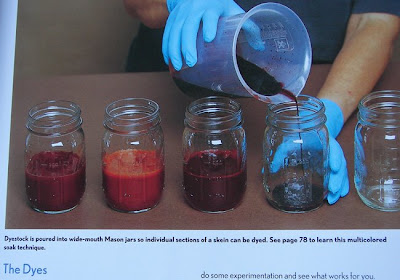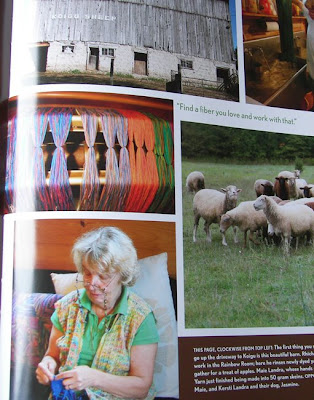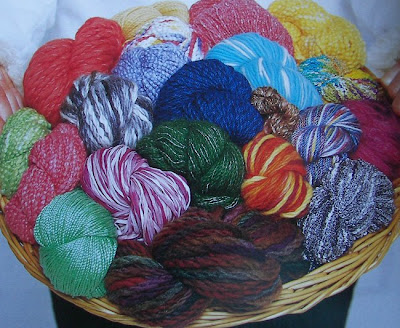Erudite Mondays at HalfSoled Boots
Volume 3, Number 3

The Yarn Lover's Guide to Hand Dyeing
by Linda La Belle
Volume 3, Number 3

The Yarn Lover's Guide to Hand Dyeing
by Linda La Belle
Well, it's been a while since I reviewed a knitting book, hasn't it? I got lost in the heady world of fiction and forgot my other passion.
As an introduction to hand dyeing, this is a pretty good book. I picked it up in the hopes that it would tell me more about plant dyes, but natural colour is not the focus of this book. La Belle takes a wider approach to the craft in this volume, starting with the basics of colour theory, materials needed, and safety.

I was interested in the pages about materials, in particular the encouragement to seek out second-hand enamel pots...the author urges me to ensure there are no chips in the enamel, which could expose the cast iron beneath, affecting the finished colour. Unless, she muses, you LIKE the way the iron changes the colour. Then, you could just keep a chipped pot for that specific colour, like the one with a quarter-sized chip that she keeps to dye a certain green, "saddened" by the iron.

Through the eight chapters of the book, she discusses seven different types of dye, including Kool-Aid and food colouring, as well as commercial acid dyes. She does include instructions for dyeing one project with eucalyptus, available from florists. I was disappointed, though, that there wasn't more discussion of natural dyes - I would have loved to see such things as cochineal, madder, or woad introduced.

I particularly loved the interviews she conducts with seven hand-dyers, including Koigu's Maie Landra. The author has actually visited the studios of all seven dyers, taking beautiful photographs of their works in progress. She includes little details, which are so endearing, about the dyers, their products, and their process.

Also included are twenty patterns for using hand-dyed yarn. The patterns are all quite simple, and range from hats and scarves, to poncho and wrist warmers. There is a very cute pair of ruffle-topped baby socks, the project dyed with eucalyptus.

The photos in this book are really beautiful - they make me want to go to the dyers' studios - or at least buy some of the featured yarn. It's a lovely book for flipping through, looking at the colours.

I would like to give dyeing a try, though I think I would need more space than my current living situation allows. There is enough guidance given in this book to get me off to a good start. I will be seeking out other sources of information on plant dyes, though, which I'd like to try first.
As an introduction to hand dyeing, this is a pretty good book. I picked it up in the hopes that it would tell me more about plant dyes, but natural colour is not the focus of this book. La Belle takes a wider approach to the craft in this volume, starting with the basics of colour theory, materials needed, and safety.

I was interested in the pages about materials, in particular the encouragement to seek out second-hand enamel pots...the author urges me to ensure there are no chips in the enamel, which could expose the cast iron beneath, affecting the finished colour. Unless, she muses, you LIKE the way the iron changes the colour. Then, you could just keep a chipped pot for that specific colour, like the one with a quarter-sized chip that she keeps to dye a certain green, "saddened" by the iron.

Through the eight chapters of the book, she discusses seven different types of dye, including Kool-Aid and food colouring, as well as commercial acid dyes. She does include instructions for dyeing one project with eucalyptus, available from florists. I was disappointed, though, that there wasn't more discussion of natural dyes - I would have loved to see such things as cochineal, madder, or woad introduced.

I particularly loved the interviews she conducts with seven hand-dyers, including Koigu's Maie Landra. The author has actually visited the studios of all seven dyers, taking beautiful photographs of their works in progress. She includes little details, which are so endearing, about the dyers, their products, and their process.

Also included are twenty patterns for using hand-dyed yarn. The patterns are all quite simple, and range from hats and scarves, to poncho and wrist warmers. There is a very cute pair of ruffle-topped baby socks, the project dyed with eucalyptus.

The photos in this book are really beautiful - they make me want to go to the dyers' studios - or at least buy some of the featured yarn. It's a lovely book for flipping through, looking at the colours.

I would like to give dyeing a try, though I think I would need more space than my current living situation allows. There is enough guidance given in this book to get me off to a good start. I will be seeking out other sources of information on plant dyes, though, which I'd like to try first.
4 comments:
I want to dye with onion and with beets this summer (when the yarn can be hung outside to dry).
Nice review, let's me know what the book offers.
Oh! I like the pictures of the sheep.
You might want to check out the Knitting History blog . . . Julia is a history prof, intelligent, and has worked with natural dyes. She might have links in her sidebar, or could point you in the right direction in you emailed her. She's super nice, and I really should catch up on her posts . . .
Hth!
to see the range of lovely colours available from eucalyptus visit www.indiaflint.com - all produced without adding synthetic mordants
Post a Comment